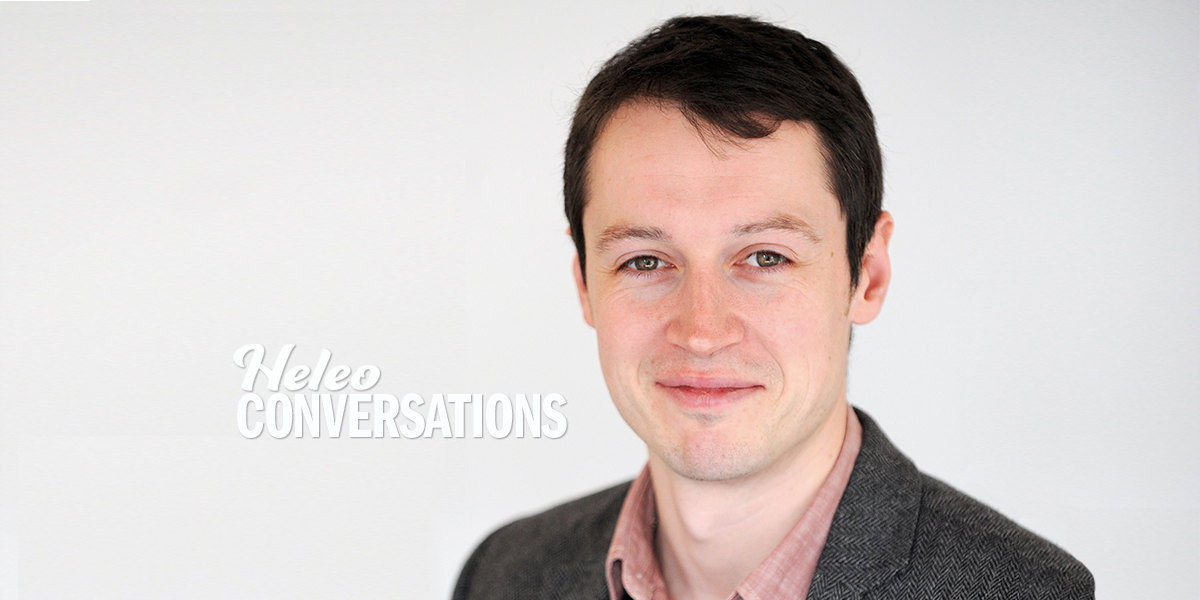Keith Houston is the author of Shady Characters: The Secret Life of Punctuation, Symbols & Other Typographical Marks and most recently, The Book: A Cover-to-Cover Exploration of the Most Powerful Object of Our Time. He recently joined Heleo’s Mandy Godwin for a conversation about the most surprising aspects of the book’s past and the possibilities for its future.
Mandy: What inspired you to create and research this project?
Keith: Shady Characters is about punctuation, but really ended up being about the history of writing and written communication. Broadening the topic, The Book is a record of literally everything I learned writing Shady Characters. Or at least all the interesting stuff.
Mandy: What was that research process like?
Keith: Someone asked me that at an event in Edinburgh, and she said, “Where do you start from?” I said, “Well, often Wikipedia.” Everyone in the audience looked horrified. My parents were there. They looked to me as if to say, “My god, what have you said?” Which I understand sounds like cheating, or like a facile way to do it, but actually it works really well. It turns out that, if Wikipedia does anything well, it points you in the direction of really useful original sources. People aren’t defacing pages about the history of paper, obviously. You can be relatively sure that it’s a good place to start.
I did most of my work in the National Library of Scotland. From there it’s looking through academic papers, which in turn take you to other academic papers. Then ultimately you find what is often the canonical work in a particular subject. There’s one book about the history of paper, for example, that was a brilliant starting point for almost everything that I talked about, and that sends you off on different tangents.
In a sense, it’s traditional reading. You start somewhere and it tells you to go somewhere else.
Mandy: Since you started as a kind of novice, what things that you found while researching were the most surprising to you?
Keith: It’s difficult to quantify surprising. If almost everything you’re reading is new to you, then almost everything is surprising.
Trending: Navy SEAL Secrets for High Performance Under Pressure
The thing that I hadn’t appreciated was that so much of the history of the book came from elsewhere, from China mostly. Just the invention of paper, which is absolutely vital, and then printing. I visited the Gutenberg Museum in Mainz, which is a printing history museum. They have a type case full of Chinese movable type, and it’s gigantic. Western ones are about the same size as a writing desk. This Chinese type case, it wraps around you, like standing in a circular telephone booth entirely filled with type. To learn that that had come out of China was quite surprising, and it was quite nice to be able to take an excursion from the Gutenberg story, which is quite widely written about.
Mandy: Right, you present a lot of world history as involved with the creation of the book. Many times in the education system, we learn about the creation of the printed word only through a European lens.
Keith: It’s relatively well-known that Gutenberg didn’t invent movable type. I’m not sure how many people would be able to say, “But this is how it actually happened.” It was refreshing to see that, refreshing to find out that you’re not the center of the world. Especially in Britain at the moment, the Brexit vote having come and gone, there is a lot of slightly distasteful, almost post-imperial nationalism. In hindsight, I’m quite glad that I was able to do that—it’s nice to disabuse us of our notions of superiority, or that we’ve invented everything that’s worthwhile. We really haven’t.
Mandy: You’ve done a lot of work with history of different aspects of language, and one of the things I found really interesting was how a lot of it seemed accidental. The history of the book seemed like, in many ways, what people had on hand at the time.
Keith: Yeah. One of the odd things is that if you look at most of the materials that go into writing, go into making books, no one attached their names to lots of these developments. Like when you go from the Coptic stitched book, where each individual gathering is sewn to the one next to it, to the invention of double cord binding, where you string a bunch of more robust cords on a frame and sew the gatherings individually to those cords. You end up with a much stronger book. No one claimed that. No one said, “I invented this.”
“They weren’t remarkable enough at the time to warrant someone going, ‘Ah, lo, I have invented the paged book.’”
Even when you look at paper, and Cai Lun says, “I invented this,” he didn’t. It’s interesting that there is not more concrete historical proof. For many developments, someone just does it. Some anonymous person, book vendor, maker, printer, or scribe, and it’s taken up very widely, and that’s just the way that things are done from then on. Perhaps we’re more obsessed with assigning intellectual property rights these days.
I don’t know if accidental is the right word, but I think a lot of things have just happened naturally. They weren’t remarkable enough at the time to warrant someone going, “Ah, lo, I have invented the paged book.” That was somewhat frustrating when you’re trying to write a book where we want histories that have big important personages in them. We want to be able to point to an event and go, “Look, this is the big bang of when the book was invented.” In fact, we don’t know when, how, why, or by whom the book was invented. I spent a long time trying to carve out some sort of useful nub of information. The paged book is really important, and we don’t know who invented it, or why. The fact that we don’t, I think, is quite telling.
Mandy: It does speak to a change in what we think of as innovation now, and the innovation mindset.
Keith: I was trying to write something about this recently for the Journal of the Society of Authors in the UK. The editor asked me to write about the difference between books and ebooks. For me, the main thing is that the book evolved. It was a very naturalistic process. With the ebook, we took a thing that existed, and we imprisoned it on a tablet or e-reader.
I’ll happily read a novel on a tablet, but I feel like I’m missing the physical interaction. It feels like using a sledgehammer to crack a nut, like we’ve done nothing with the ebook format to warrant it existing. The web is the way to go. You get very creative stuff on the web, whereas the notion of an ebook, I find it’s weird. It’s an Innovation with a capital “I.” It’s not an invention, I don’t think it’s a breakthrough just yet. Ebook has to become a more compelling thing for me. Or it’ll disappear, it’ll just become part of some continuum of other digital media.
Mandy: It’s really interesting talking about the digital media experience as opposed to the ebook experience.
Keith: Ebooks feel really static. The Shady Characters blog is also really static, but at least it has hyperlinking. At least it acknowledges that it’s a chronological form, that you might want to look at it organized by date, or by tag, or by search. Ebooks just feel very odd. I think we’re doing it because we can, not because the experience of reading an ebook is better than reading a print book. It’s more portable, it’s more convenient. I sometimes struggle to see what the advantage is.
Trending: How to Make Menopause the Best Time of Your Life
Mandy: It’s often hard for me to think of books as physical objects, because reading is so imaginative. When you were putting together this project, did you feel like learning about the production of books changed your relationship to reading?
“Weirdly, as I was writing about the physical form of the book, I was paying almost no attention to the physical forms of the books in front of me. Which I think probably says a lot about how efficient or well-adapted we are to reading books.”
Keith: It did to an extent. One of the things that I realized is that I must have checked out hundreds of books at the National Library, and they all become transparent after a while. The physical book is quite a good way to hold certain kinds of information, and so you get very adept at finding exactly the thing you want, reading the surrounding chapter or chapters, taking notes, and then moving on. Weirdly, as I was writing about the physical form of the book, I was paying almost no attention to the physical forms of the books in front of me. Which I think probably says a lot about how efficient or well-adapted we are to reading books.
I came across a couple of books, one of which was about making parchment, and I thought, “This covering material seems weird.” It was actually parchment. I’d never touched it or seen it, so I immediately went home and ordered some parchment on the internet, because that’s a thing you can do. Then I got a pen and practiced writing on it. That woke me up to the possibilities in the physical book. There was another book about making papyrus, which had a sheet of papyrus pasted into it, and I stopped and thought, “Wow, that’s really cool. I’ve never seen this.” Again, I went and bought some papyrus on the internet, which is also a thing you can do. I got some reed pens, in the Roman style, and had a go at writing. Which is why I say in The Book, “This is not a pleasant experience.” It’s quite scratchy.
It only took a couple of books to make me look twice at the books that I pick up. If you’re going into a book shop and buying a mass market paperback then it’s not going to tell you a great deal, or it’s not going to be an especially edifying object. As I was writing The Book, I spent a lot of time talking about why books are sewn together, how they’re sewn together, different ways of sewing them together. Then, I was reading about the guy who started to bind books using rubber cement. You take the gatherings, shave off the spine, and then paint on a number of coats of rubber cement. This is the birth of the modern, perfect-bound book, where they simply glue them together. I thought, “Oh, this is bad. I’ve spent thousands of words saying that you should open this book in a particular way, look for the threads, which mean the gatherings, look how the spine curves in this particular way, and we don’t make books like that anymore.”
It was quite lucky that the publishers ended up finding a factory in China that could do it economically. Factories in the West don’t have the machinery anymore, so it’s very expensive to have books sewn together. That was a big relief, to know that The Book would be useful as a point of reference. Which meant I could say, “Take the book that is literally in your hands and look at it in this way.” Which will not translate well to an ebook.
Mandy: What sort of decisions went into the actual physical process of making your book, and were you involved in that?
Keith: I’d say you’re always involved. The questions were very straightforward. They were, “Can we afford to have this sewn,” and the answer ultimately was yes, which was great. The cover design was interesting. I hadn’t appreciated that the boards were going to be uncovered. Actually, The Book might refer to itself incorrectly at one point. It talks about turn-ins, which are the little flaps that you fold over at the edges of the covering material, and then you glue onto the inside of the cores, but it doesn’t do that.
“The text of The Book depended upon the physical form of the book, which probably doesn’t happen very often.”
The other big thing was the paper. I had this idea for a blank page that would be an image of the paper, with a little caption at the bottom explaining what paper was and how it’s made. That had to wait until the last minute. I had to be absolutely sure that we knew what sort of paper we were using. In fact, even down to the number of pages. That was quite interesting. The text of The Book depended upon the physical form of the book, which probably doesn’t happen very often.
Mandy: I’m sure that rarely happens.
Keith: You’ll have the typeface mentioned in some books, but that’s about it. The compositor —the person who’s putting in the text—can do that for you, whereas I wanted to pull together information from the production people, as well. Even ultimately, the factory. The production people at Norton ended up corresponding with the factory that was making The Book in order to find out how it was all going to be put together. They had more work to do for this one.
Trending: Microsoft, Google, and Beyond: What Business at the Cutting-Edge of AI Looks Like
Mandy: Why do you think that at this moment this is such a relevant study?
Keith: I think that most people who are involved in making books, or writing them, are acutely aware that there’s a very big shift happening. Publishers are worried that Amazon is eating their lunch. My agent, for example, is worried about what ebooks mean. I’m sort of ambivalent. As long as the book gets out there then I’m happy. It’s clearly very important for this one to be out there in physical form. Book shops as well, of course. Your average physical book shop is pretty worried.
I think what might happen is that the physical book might end up being treated as a kind of special physical object, a hallowed thing a bit like a vinyl record, that is a vestigial physical representation of content. I find it quite interesting that lots of people talk about content nowadays. We’ve finally managed to abstract the idea of the information from the medium that carries it. People are comfortable with the idea of books as content, of a narrative of a roughly similar length that you read in a sequential way. Now that we’ve done that, now that we’ve managed to divorce the idea of what a book is in terms of content from how you read it, it does raise interesting questions with what physical books are for.
It occurred to me that libraries are almost like museums. When you have a library like the National Library of Scotland, where they might have the only publicly accessible copy of a book anywhere, then suddenly that physical book becomes very important. Every book can be used like an exhibit or a holding in a museum.
“You can go to a book shop and you literally just exist in it. You’re already interacting with books and with the shop just by the mere act of being there.”
I wondered, then, if bookshops are almost like churches. There’s a certain amount of ritual. You go in, browse around, pick up a book, maybe sit down and read a few pages, and then you give your offering at the end and take your religious artifact away with you. Humans, we’re all about physical contact, about spending time with other humans, even if it’s in silence. There’s a communal aspect to physical book shops that I haven’t seen elsewhere online. There are lots of forums for people that are interested in writers, but forums take a lot of effort. In order to be present in a forum you need to be posting, you need to be engaging with it, whereas you can go to a book shop and you literally just exist in it. You’re already interacting with books and with the shop just by the mere act of being there.
I’m in no way a humanities scholar, but I think that there is something quite important, almost ritualistic, about the fact that book shops exist, and that we interact with them in a particular way. We’ll lose that. I think that that will eventually go, especially the larger ones. It seems to me a bit like record shops, that the larger records shops have all disappeared, but the smaller independent ones have survived. I do wonder if that’s what future holds for the book shop.
Mandy: If that’s the reason that they’ve survived?
Keith: Yeah, exactly. They treat themselves as idiosyncratic little communities, or they specialize in one particular thing. I’m guessing that there is little incentive for most book shops to stock the average James Patterson thriller. They just don’t care, right? Amazon does that. There’s no need for anyone to give two shits over what the latest James Patterson looks like physically. They just want to consume the words. If you’re talking about books that have a more striking and more interesting physical incarnation, then book shops are important and interesting.
It’s difficult for me to know, I’ve only written a couple of books, but it does feel like people that deal with books, people in the publishing industry, are quite excited about this one. In a way I think it’s because someone is talking about what they do on a daily basis, but also because a lot of work went into making it look the way it does.



























